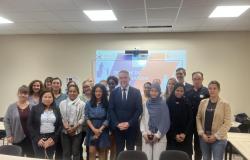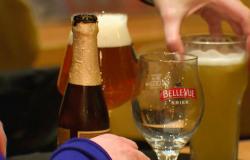With 60,000 new cases each year and 12,000 deaths per year, breast cancer is the leading cause of cancer death in women, according to Public Health France. Although the average age of cancer diagnosis is 64, nearly 20 % of women are affected by a breast tumor before the age of 50, or around 12,000 women each year.
Fanny Thauvin is a volunteer with Jeune et Rose, a collective of young women who faced breast cancer between the ages of 20 and 40 and decided to mobilize together. She runs prevention workshops in high schools, communities or businesses, and is part of the scientific monitoring working group on the environmental factors of cancer.
Reporterre — You organize breast cancer prevention workshops: how do you approach the environmental issue ?
Fanny Thauvin — We address all the factors linked to breast cancer, placing the figures in their context. We know that around a third of breast cancers are called « avoidable » — because linked to individual behaviors such as smoking, alcoholism or a sedentary lifestyle. We also know that 10 % of breast cancers are of genetic origin. Which means the rest — 55 to 60 % of cancers — originates from environmental factors. In other words, environmental pollution (air pollution, pesticides, endocrine disruptors) play a major role in the appearance of cancers.
This is why we are critical of certain communications, particularly during Pink October, which highlight individual risky behaviors, such as tobacco or alcohol. These are certainly important factors, but they are not the only thing ! For us, this focus individualizes the fight, and establishes a form of guilt for women who have cancer… This would mean that if we die of cancer, it is somewhat our fault. But among us, there are plenty of women who have never smoked and drank very little.
During prevention workshops, we talk a lot about environmental factors, providing concrete adaptations in our daily lives. Decipher food labels (you can do this easily with the Yuka application) to track down carcinogenic sweeteners, pay attention to household products and cosmetics that contain phthalates, and monitor air quality. Our speech is: « Of course, legislation is needed on this, but in the meantime, here is what can be done. »
We are often told that we are missing data, that we need to be sure before banning a substance. But there are a certain number of studies which should encourage the precautionary principle. L’OMS [Organisation mondiale de la santé] ranked France as the first country for the incidence of breast cancer: this should push us to act !
Why target young women in particular around breast cancer ?
There is an increase in cases of breast cancer among young adults, although there is a lack of data. According to a study published in 2023, there would have been an increase in these cancers of 80 % among those under 50 between 1990 and 2019. In France, those under 50 represent 20 % of cancer cases, or 12,000 cases each year.
However, young women are still often off the radar of prevention measures. Because you can’t imagine having cancer before the age of 50. We saw that this population could fall ill outside of organized screening and therefore that breast self-examination had a real health benefit to avoid late screenings which jeopardize recovery.
In our workshops, we teach participants to observe themselves, to feel themselves, to identify the visual symptoms that should prompt us to consult a professional. We give advice, such as going to the armpits and collarbones and not staying at breast level. Feel under your finger when a ball has an appearance « stony » which should alert us.
For us, it should be a routine, an exam that we do once a cycle, away from periods. Our workshops are not at all closed to the older public, on the contrary. On the other hand, they are provided by young female patients of the association, in treatment or in remission.
What’s Wrong with Breast Cancer Prevention? ?
We believe that breast self-examination is an essential tool, free and without delay, that too few people say they know how to practice.
However, we see the limit. Reducing the incidence of cancer requires looking at the triggering factors upstream. As long as we don’t treat at the source, we can screen as much as we want, we won’t solve the problem.
Hence the creation of this internal working group on environmental factors. We also support the creation of a national registry. In Europe, France is the only country, with Spain, not to have a national register which brings together all the data on people with cancer — only 25 departments do this monitoring. However, this type of register makes it possible to highlight occupational diseases and particularly vulnerable areas. And in fineto be able to consider more effective prevention measures.
Workshops « squeaker », « telenipple »… You approach this serious subject with humor, and with a festive aspect: why this choice ?
We are convinced that by spreading the message in this way, we increase the chances that people with nipples will be more aware of the risk factors, and above all will start performing breast self-examinations. By not dramatizing the gesture and suggesting to them that the« we check that everything is okay » — and not that we « search for a suspicious mass » —, this poses a more positive intention.
legend






